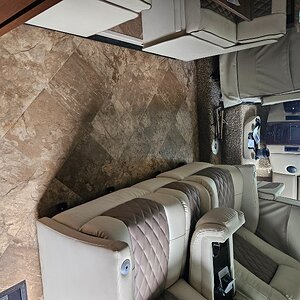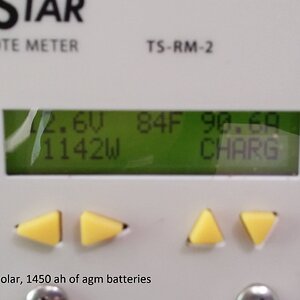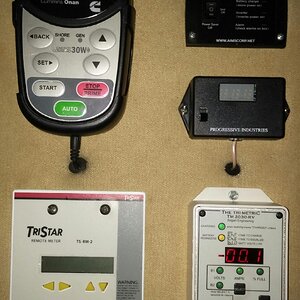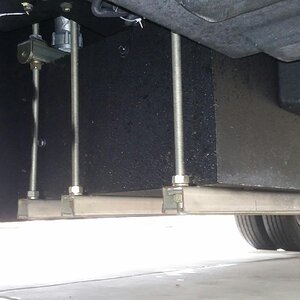Navigation
Install the app
How to install the app on iOS
Follow along with the video below to see how to install our site as a web app on your home screen.
Note: This feature may not be available in some browsers.
More options
Style variation
Welcome to RVForums.com
- Register now and join the discussion
- Friendliest RV Community on the web
- Modern site for PC's, Phones, Tablets - no 3rd party apps required
- Ask questions, help others, review campgrounds
- Get the most out of the RV Lifestyle
- Invite everyone to RVForums.com and let's have fun
- Commercial/Vendors welcome
You are using an out of date browser. It may not display this or other websites correctly.
You should upgrade or use an alternative browser.
You should upgrade or use an alternative browser.
Battery life
- Thread starter RC9660
- Start date
Neal
Administrator
- Joined
- Jul 27, 2019
- Messages
- 13,885
- Location
- Midlothian, VA
- RV Year
- 2017
- RV Make
- Newmar
- RV Model
- Ventana 4037
- RV Length
- 40' 10"
- Chassis
- Freightliner XCR
- Engine
- Cummins 400 HP
- TOW/TOAD
- 2017 Chevy Colorado
- Fulltimer
- No
- Joined
- Jan 19, 2021
- Messages
- 3,614
- Location
- Rosemary Farm
- RV Model
- Between RVs
- TOW/TOAD
- Toadless
- Fulltimer
- No
Give this a read: How To Maintain Batteries - Deep Cycle Battery Store It will help you get more life out of your batteries.
As to “more expensive batteries worth the price tag”, it depends on what they are selling. AGM batteries cost more and are a better fit for RVs for a number of reasons. But one brand over another is pretty subjective. Look at battery specs, where they are made, and even weight.
As to “more expensive batteries worth the price tag”, it depends on what they are selling. AGM batteries cost more and are a better fit for RVs for a number of reasons. But one brand over another is pretty subjective. Look at battery specs, where they are made, and even weight.
Scooterfan
RVF Expert
- Joined
- Dec 14, 2020
- Messages
- 772
- Location
- Central Coast of California
- RV Year
- 2007
- RV Make
- Newmar
- RV Model
- Canyon Star 3205
- RV Length
- 32
- Chassis
- Workhorse w20
- Engine
- 8.1 L Vortec
- Fulltimer
- No
What's a "short life". I use the same type (Marine Deep Cycle) and treat them the same. I'm happy with five years effective life. I use the Flow-Rite watering system (easy) to maintain. I could probably get better life, but I'm not going to disconnect until I buy new ones  I use Interstate Marine Deep Cycle from Costco. Blessings
I use Interstate Marine Deep Cycle from Costco. Blessings
Kevin D Pem
RVF 5K Club
- Joined
- Jul 29, 2020
- Messages
- 5,282
- Location
- AZ
- RV Year
- 1984
- RV Make
- Alpinelite
- RV Length
- 26'
- TOW/TOAD
- 2016 Ram 1500
- Fulltimer
- Yes
Yes they are worth the price!
I place some conditions on that comment however.
AGM, Covers many types, so this is the "why" you are wondering about.
A low cycle failure rate can be attributed to the addition of antimony in the plates. The problem with a battery maintainer is the constant plating of antimony on the outside surface of the plates.
The cure for plating is not using the antimony or magnesium I believe in the plate structure.
Two batteries that I have had experience with are the spiral blue/red/or yellow top optima battery line. They have pure lead plates.
The other one is the one I currently use called the Northstar Blue+, the battery uses pure lead with a carbon additive in the negative plate. There may well be others, but these I have experience with.
Remember, pure lead, no plating, the plates will give up the power stored in them. And all lead batteries are likely to use antimony/magnesium in the plates to make them physically stronger, except for these two that I know of, there may be others.
I place some conditions on that comment however.
AGM, Covers many types, so this is the "why" you are wondering about.
A low cycle failure rate can be attributed to the addition of antimony in the plates. The problem with a battery maintainer is the constant plating of antimony on the outside surface of the plates.
The cure for plating is not using the antimony or magnesium I believe in the plate structure.
Two batteries that I have had experience with are the spiral blue/red/or yellow top optima battery line. They have pure lead plates.
The other one is the one I currently use called the Northstar Blue+, the battery uses pure lead with a carbon additive in the negative plate. There may well be others, but these I have experience with.
Remember, pure lead, no plating, the plates will give up the power stored in them. And all lead batteries are likely to use antimony/magnesium in the plates to make them physically stronger, except for these two that I know of, there may be others.
Travelskip
RVF Regular
- Joined
- Aug 24, 2023
- Messages
- 6
- Location
- St. Petersburg, FL
- RV Year
- 2007
- RV Make
- Keystone Cougar
- RV Model
- RLS291
- RV Length
- 30‘
- Fulltimer
- No
I think nowadays it is wise to go the LFP battery route.
Less weight and more capacity. And no worries having them sit for months.
Any lead acid battery can only use about 50% of its rated capacity without damaging it prematurely.
Not so with a LFP battery. You can get the full capacity out of it. . . if you need to.
And they don't require any maintenance. No corroded contacts, no water to replenish.
Less weight and more capacity. And no worries having them sit for months.
Any lead acid battery can only use about 50% of its rated capacity without damaging it prematurely.
Not so with a LFP battery. You can get the full capacity out of it. . . if you need to.
And they don't require any maintenance. No corroded contacts, no water to replenish.
Wemustrv
RVF Supporter
- Joined
- Apr 13, 2022
- Messages
- 1,022
- Location
- Ely, Iowa
- RV Year
- 2007
- RV Make
- Coachman
- RV Model
- Encore 40TS
- RV Length
- 40"
- Chassis
- Freightliner
- Engine
- 330 hp Mercedes Benz
- TOW/TOAD
- 2019 Ford F150 SuperCrew
- Fulltimer
- No
There is one issue with the lithium batteries they do not handle extreme cold very well. Otherwise a great choice.I think nowadays it is wise to go the LFP battery route.
Less weight and more capacity. And no worries having them sit for months.
Any lead acid battery can only use about 50% of its rated capacity without damaging it prematurely.
Not so with a LFP battery. You can get the full capacity out of it. . . if you need to.
And they don't require any maintenance. No corroded contacts, no water to replenish.
Wemustrv
RVF Supporter
- Joined
- Apr 13, 2022
- Messages
- 1,022
- Location
- Ely, Iowa
- RV Year
- 2007
- RV Make
- Coachman
- RV Model
- Encore 40TS
- RV Length
- 40"
- Chassis
- Freightliner
- Engine
- 330 hp Mercedes Benz
- TOW/TOAD
- 2019 Ford F150 SuperCrew
- Fulltimer
- No
I have switched my batteries to AGM Absorption glass mat and I love them. I looked at Lithium however while great performers they one draw back is very cold. Lithium do not like extreme cold and should be removed is sitting in cold for long periods. There are Lithium batteries with built in technology to help this issue.I use a deep cycle lead acid battery and when not dry camping leave my trailer plugged in year round. Still batteries seem to have a short life. Are the more expensive batteries worth the price tag?
Travelskip
RVF Regular
- Joined
- Aug 24, 2023
- Messages
- 6
- Location
- St. Petersburg, FL
- RV Year
- 2007
- RV Make
- Keystone Cougar
- RV Model
- RLS291
- RV Length
- 30‘
- Fulltimer
- No
The cold is not as big of an issue like people think. If the battery temp is below 32F just charge with 0.1C and below 14F charge with only 0.05C
And as Wemustrv mentioned, the battery and BMS manufacturers took this in consideration and most good LFP batteries have now a heating element inside.
I am using LFPs to power my office in case of the numerous power outages we have in FL and have also one in my 5th wheel.
And as Wemustrv mentioned, the battery and BMS manufacturers took this in consideration and most good LFP batteries have now a heating element inside.
I am using LFPs to power my office in case of the numerous power outages we have in FL and have also one in my 5th wheel.
Kevin D Pem
RVF 5K Club
- Joined
- Jul 29, 2020
- Messages
- 5,282
- Location
- AZ
- RV Year
- 1984
- RV Make
- Alpinelite
- RV Length
- 26'
- TOW/TOAD
- 2016 Ram 1500
- Fulltimer
- Yes
The 32 degree is a big number! Dendrites are formed charging below that temperature.The cold is not as big of an issue like people think. If the battery temp is below 32F just charge with 0.1C and below 14F charge with only 0.05C
And as Wemustrv mentioned, the battery and BMS manufacturers took this in consideration and most good LFP batteries have now a heating element inside.
I am using LFPs to power my office in case of the numerous power outages we have in FL and have also one in my 5th wheel.
The battery works as a heater simply by discharge, any BMS is designed to protect the battery.
There is nothing more dramatic than lithium on melt down. Melt down happens when the battery reaches that magic number. That number can be reached when the Dendrites grow large enough, or high loads are applied bringing the temperature up to that magic number.
One thought!!! Electronics never fail!!!
Wemustrv
RVF Supporter
- Joined
- Apr 13, 2022
- Messages
- 1,022
- Location
- Ely, Iowa
- RV Year
- 2007
- RV Make
- Coachman
- RV Model
- Encore 40TS
- RV Length
- 40"
- Chassis
- Freightliner
- Engine
- 330 hp Mercedes Benz
- TOW/TOAD
- 2019 Ford F150 SuperCrew
- Fulltimer
- No
We store our motorhome in the winter and in Iowa it can get to -30 or colder with -104 degree wind chill this would not be a good setting for LFP unless powered up or a good trickle charger. We do keep ours powered up however if we had a power failure in this weather the LFP batteries would be toast.
Joe Dutchstar
RVF Supporter
- Joined
- Nov 3, 2019
- Messages
- 3,643
- Location
- Florida
- RV Year
- 2024
- RV Make
- Newmar
- RV Model
- Dutch Star 4311
- RV Length
- 43
- Chassis
- Spartan
- Engine
- Cummins
- TOW/TOAD
- 2018 Ford Flex
- Fulltimer
- No
Kevin D Pem
RVF 5K Club
- Joined
- Jul 29, 2020
- Messages
- 5,282
- Location
- AZ
- RV Year
- 1984
- RV Make
- Alpinelite
- RV Length
- 26'
- TOW/TOAD
- 2016 Ram 1500
- Fulltimer
- Yes
Sitting is not the problem, charging is. There is nothing to freeze, but charging under your stated conditions could burn the place down.We store our motorhome in the winter and in Iowa it can get to -30 or colder with -104 degree wind chill this would not be a good setting for LFP unless powered up or a good trickle charger. We do keep ours powered up however if we had a power failure in this weather the LFP batteries would be toast.
TheLooks
RVF Supporter
- Joined
- Jun 30, 2021
- Messages
- 1,131
- Location
- Harrison, TN
- RV Year
- 2011
- RV Make
- Jayco
- RV Model
- 26 BH
- RV Length
- 29 ft
- Fulltimer
- No
Kevin D Pem
RVF 5K Club
- Joined
- Jul 29, 2020
- Messages
- 5,282
- Location
- AZ
- RV Year
- 1984
- RV Make
- Alpinelite
- RV Length
- 26'
- TOW/TOAD
- 2016 Ram 1500
- Fulltimer
- Yes
I believe comparable to other tech.And no one mentioned the cost of LiPo....
Latest resources
-
-
Trueline Leveling System (Valid Air)Operation & Service Manuals for the Valid Air leveling system
- Jim
- Updated:
-
-
Notes on the Electrical Systems of the Roadtrek Zion Family of RVsNotes on the Electrical Systems of the Roadtrek Zion Family of RVs
- dilbertjth
- Updated:
-












